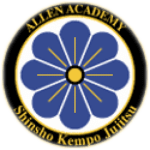

ALLEN MARTIAL ARTS ACADEMY
Jujitsu can be translated as the “gentle art” or “flexible skill” or even the “essences of the gentleness and flexibility in a combat art”. It is a grappling art whose origins have been lost in antiquity. Regardless of how Jujitsu began, it developed into a powerful system of self-defense, which has been the parent art to such modern arts as Judo, Brazilian Jujitsu and Aikido. It is a system of balance disruption, wrestling, throwing, joint locking, choking, and submission.
The higher levels of this system reveal an intricate and beautiful system of effortless effort that includes precise striking of nerve centers, balance disruption of adversaries for throws, sweeps and takedown, powerful projections, and dynamic Ki (Chinese chi) development.
It perfectly complements the Kempo system. Jujitsu and Kempo have been paired together for so long it is truly difficult to tell where one begins and the other ends.
There is controversy as to what influence Ch’uan Fa (Kempo), especially Chin Na, has had on Jujitsu. It is known that China and Japan traded heavily during the formative years of Japan’s development. It was during this time that Japan adopted many things from their neighbors across the sea, such as the What is Jujitsu?Chinese written characters and many social traditions such as Zen (known in China as Chuan), the study of Confucian thought, and the philosophies of the Do (Taoism). Regardless of what exact relationship there is between the origins of Chin Na and Jujitsu, the two systems are practically identical in their application today.
Jujitsu as taught today, encompasses empty-handed self-defense techniques developed from the centuries old military arts (Bujitsu) of the Japanese Samurai Warriors. Though the history of Jujitsu may well be considered to have begun in the second or first century BC, its renaissance, or “golden age”, was during the Tokugawan era (1603 – 1867 AD). The term Jujitsu, formulated in the Tokagawan era, translates to the art (Ju) of yielding, softness, suppleness, or pliability (Jitsu), meaning combative way.
When Kempo arrived on the shores of the mainland from Hawaii, it was filled with Jujitsu. Although some Kempo systems claim to contain Jujitsu, this is the stand up variety as opposed to a complete system. Keep in mind that the original name for Hawaiian Kempo was Kempo Jujitsu. It was full of stand up and ground fighting techniques that would rival any other system. Unfortunately, this had been lost due to a lack of awareness. Thanks to the re-emergence of Jujitsu, many Kempo stylists are now rediscovering the Jujitsu of their original curriculum.
Contact Allen Academy
10600 Magnolia Ave
Riverside, CA 92505
(951) 354-0244
info@schoolmartialarts.com
© 2020 Allen Martial Arts Academy